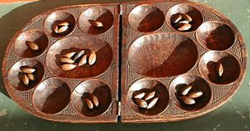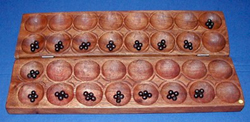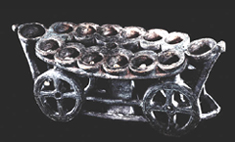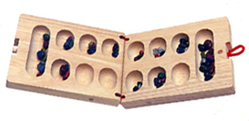Mancala Game
Mancala is a generic name for this type of “count and capture” game and stems from the Arabic word which means “to move.” Examples of this game have been found in Egyptian ruins dated from 1400 B.C.E. — carved into the temple roofs of Memphis, Thebes and Luxor. Some even place Mancala among the oldest games in the world, with archaeological evidence reaching back perhaps as far as 6000 B.C.E. in Jordan. It is played all over Africa with two basic variations. North of the equator they use a “two-rank” board; south of the equator, a “four rank” board is used. The slave trade brought the game to the Caribbean and the east coast of South America.
Make Your Mancala!
The decoration and creation of Mancala boards is said to represent agriculture and landscape; a depiction of land being turned into a productive field through clearing plowing, irrigation, and harvesting.

This lesson would be best suited for a pre-museum visit and is a great way to introduce students to African culture.

Let’s Get Started:
Materials:
- Egg cartons (one-dozen-sized container)
- Scissors
- Paint
- Paintbrushes
- Markers
- Water Cups
- Paper Towels
- Suitable game pieces: beans, paperclips, buttons, etc.
- Tape
- Glue
- Stapler
- Other materials (be creative!)
Overview:
Start the class with some basic historical information on Mancala. You may use the information we’ve provided or research further.

Show examples of the game to the class. It may be best to show both African versions as well as American versions. See if children can pick up on the similarities and differences between the two.

Make the Mancala Game:
- Distribute decorating materials and egg cartons.
- Instruct the students to cut the top off the egg cartons along the hinge and set the bottom (the egg-holding tray) to the side.
- Cut the extra closure section off of the top of the egg carton.
- Halve the top of the carton, cutting width-wise down the middle.
- Take the two top pieces and attach them to the bottom of the remaining egg carton piece (side with cups). Attach the top pieces so they stick out enough to be the cups for the Mancala game. Attach these pieces using tape, glue or staples.
- Now the students are ready to decorate their games. Remind students of the use of symbolism in Mancala to represent agriculture, landscape and harvesting. Have them design their own board with symbols representing important aspects of their own lives, including landscapes they’ve seen or different agricultural types Americans use today. Go ahead and decorate with markers, paint or anything else they’d like!
Once the Mancala boards have dried and are ready to play with, hand out your play pieces — beans, paperclips, etc. — and explain the rules of Mancala to the class. There are many variations on the rules, so feel free to choose a different method of play. Below are the rules from Roger Louis Sinashon’s Web site:
How to play:
Sinashon’s Rules:
Place the game board between the two players, with the larger cups on the right and left of the players. The side of the board closest to each player, as well as the end cup on each player’s right belongs to that player. Players take turns picking up all the paper clips from one of their cups, (except for the right-end cups, which is where the players will collect their pieces) and redistribute the pieces around the board in a clockwise direction, beginning with the cup to the right of the one from which the player took the paper clips.
Example: On the first turn of the game, player one picks up the paper clips from the fourth cup from the right. That player would then deposit a paper clip in the third cup from the right, the second cup from the right, and finally, the right-most cup. If the first player had started with the right-most cup, he would have deposited one paper clip in his end cup, then continued around the board, depositing paper clips in his opponent’s first two cups.
If, however, player one had selected the paper clips in the third cup from the right, he would have ended by placing his last paper clip in the end cup, he gets another turn and may select the paper clips in another of his cups, continuing in the same manner.
The object of the game is to end your turn with all of the cups on your side empty (excluding, of course, your end cups). Note that in this version, the number of paperclips, if any, in the end cup has no bearing on the game play.
Student Evaluation:
After the students have played the game, it may be beneficial to hold a show-and-tell session. Have the students show the games they created and ask them questions like:
- Why did you decorate your Mancala game that way?
- Do you think such an old game is still fun?
- Why do you think African people played this game?
- Do you think it matters that your version is made out of an egg carton?
- Is it still important if it is made out of recycled materials?
- Do you see any common decorations among the class?
Additional Information:
Click here to find out more about Mancala.
